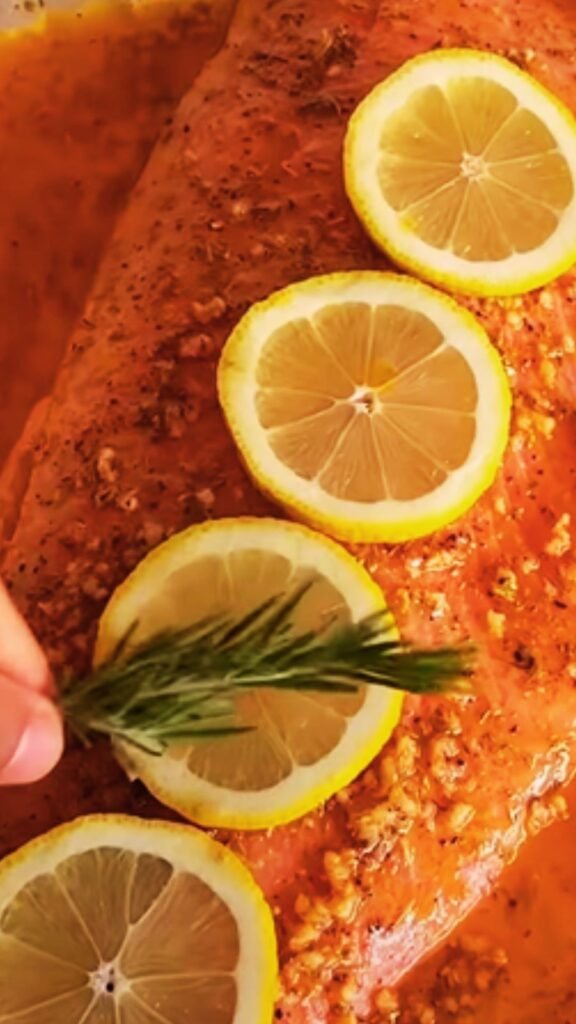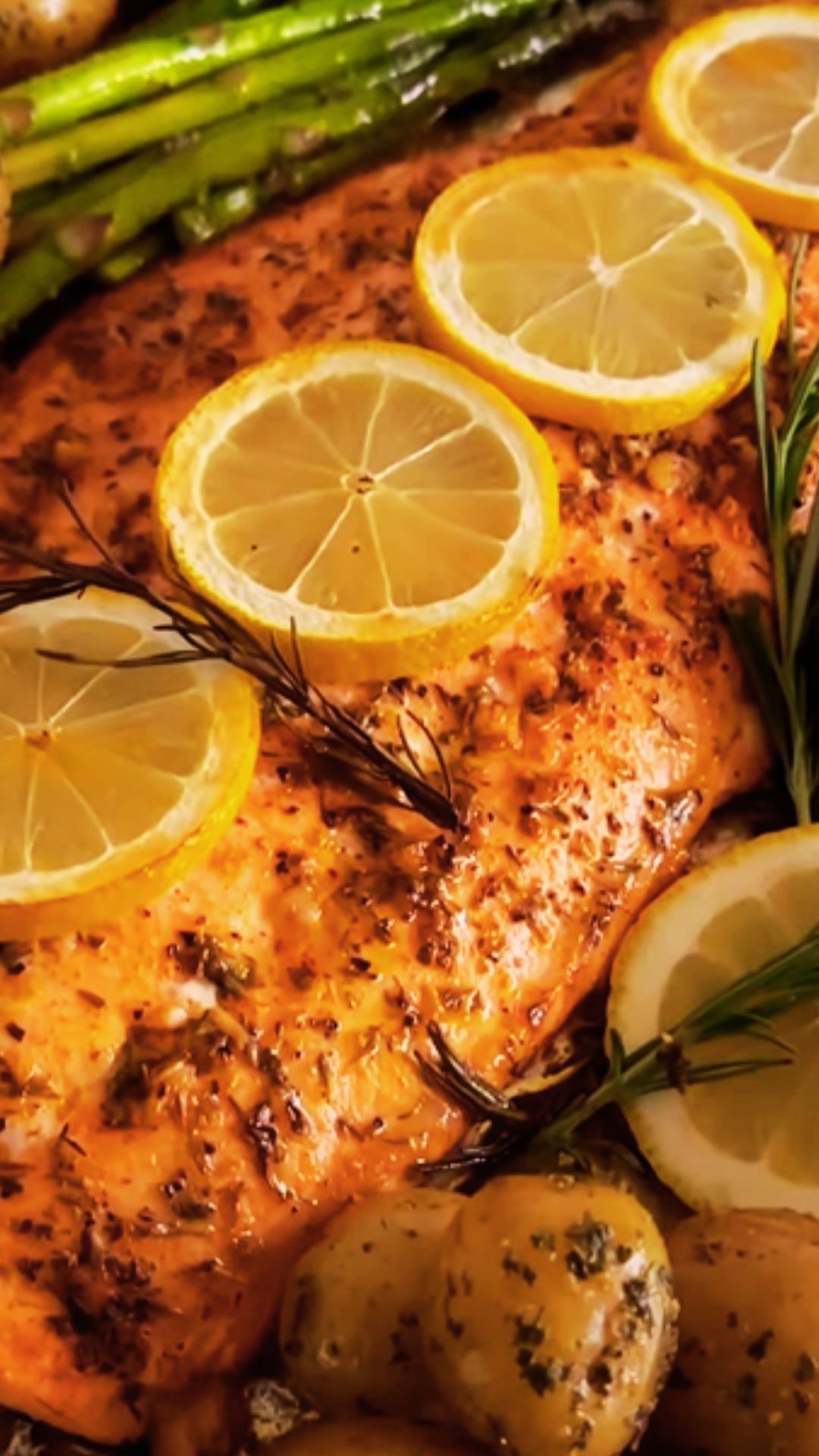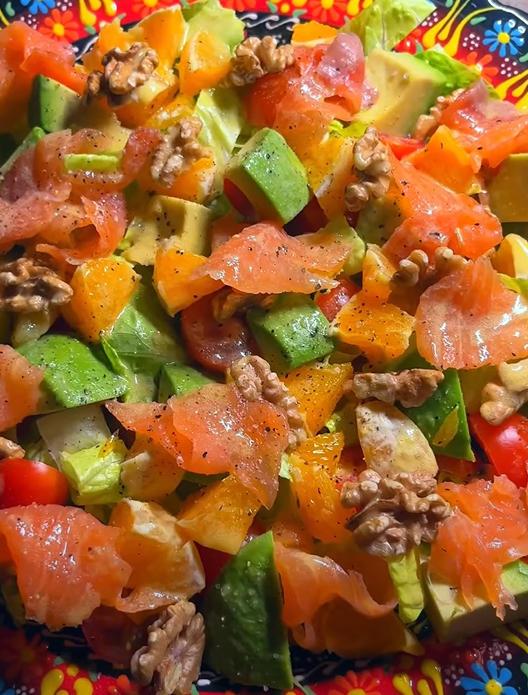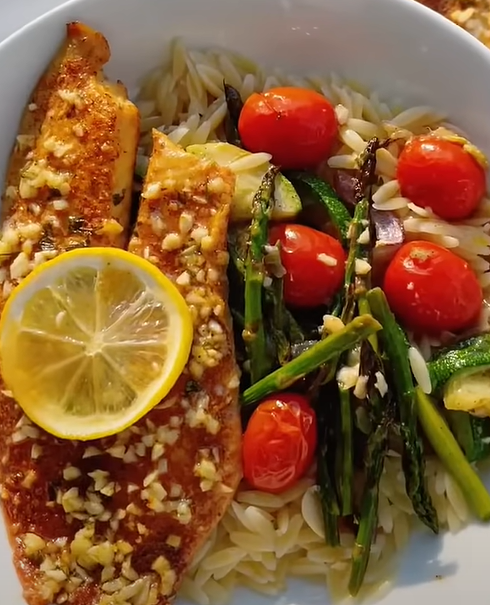There’s something magical about the combination of flaky fish, bright lemon, and aromatic garlic that transforms a simple weeknight meal into something extraordinary. I’ve been perfecting my baked fish with lemon-garlic butter recipe for years, and I can confidently say it’s become one of my most requested dishes among family and friends.
The beauty of this recipe lies in its simplicity – you don’t need fancy techniques or expensive ingredients to create a restaurant-quality meal at home. What you do need is fresh fish, quality butter, and a few pantry staples that come together in perfect harmony. The result is a dish that’s both elegant enough for entertaining and easy enough for a Tuesday night dinner.
Why This Recipe Works Every Time
I’ve tried countless variations of baked fish recipes over the years, and this lemon-garlic butter version consistently delivers outstanding results. The secret isn’t just in the ingredients – it’s in understanding how they work together to create layers of flavor that complement rather than compete with each other.
The lemon provides brightness that cuts through the richness of the butter, while the garlic adds depth without overwhelming the delicate fish. The baking method ensures the fish stays moist and flaky, while the butter creates a golden, aromatic coating that makes every bite irresistible.
Choosing the Right Fish for Your Recipe
White Fish Varieties: The best candidates for this recipe are firm, white fish that can hold their shape during baking. My top recommendations include:
- Cod: Mild flavor, flaky texture, readily available
- Halibut: Firm texture, slightly sweet taste, premium option
- Mahi-mahi: Mild flavor, sturdy texture, excellent for beginners
- Sea bass: Delicate flavor, buttery texture, restaurant favorite
- Tilapia: Budget-friendly, mild taste, widely available
Salmon Options: While traditionally made with white fish, salmon works beautifully in this recipe. The richness of salmon pairs exceptionally well with the bright lemon and savory garlic.
Freshness Indicators: When selecting fish, I always look for clear eyes (if buying whole fish), firm flesh that springs back when pressed, and a fresh ocean smell – never fishy or ammonia-like odors.
Essential Ingredients and Their Roles
| Ingredient | Amount | Purpose | Substitution Options |
|---|---|---|---|
| Fish fillets | 4-6 pieces (6-8 oz each) | Main protein | Any firm white fish |
| Butter | 6 tablespoons | Richness, flavor carrier | Ghee, olive oil |
| Fresh lemon juice | 3-4 tablespoons | Acidity, brightness | Lime juice, white wine |
| Lemon zest | 2 teaspoons | Concentrated citrus flavor | Orange zest |
| Garlic cloves | 4-5 cloves, minced | Aromatic depth | Garlic powder (1 tsp) |
| Fresh parsley | 1/4 cup, chopped | Color, fresh herb note | Dill, chives, cilantro |
| Salt | 1 teaspoon | Flavor enhancement | Sea salt, kosher salt |
| Black pepper | 1/2 teaspoon | Mild heat, complexity | White pepper |
| Paprika | 1/2 teaspoon | Color, mild smokiness | Smoked paprika |
Step-by-Step Preparation Guide
Preparing Your Kitchen and Ingredients
Before I start cooking, I always ensure my workspace is organized and my ingredients are properly prepared. This French cooking principle called “mise en place” makes the actual cooking process smooth and stress-free.
Preparation Steps:
- Preheat oven to 400°F (200°C)
- Line a baking dish with parchment paper
- Pat fish fillets completely dry with paper towels
- Mince garlic finely to ensure even distribution
- Zest lemons before juicing them
- Chop parsley and set aside for garnish
Creating the Perfect Lemon-Garlic Butter
The butter mixture is the heart of this recipe, and I’ve refined my technique over countless preparations. The key is balancing the flavors so that each component shines without overwhelming the others.
Butter Preparation Method:
- Soften butter to room temperature (this takes about 30 minutes)
- In a medium bowl, combine softened butter with minced garlic
- Add fresh lemon juice gradually, mixing constantly
- Incorporate lemon zest, salt, pepper, and paprika
- Mix until all ingredients are evenly distributed
The consistency should be smooth and spreadable. If the mixture seems too thick, add a teaspoon of lemon juice. If it’s too thin, refrigerate for 10 minutes to firm up slightly.
Seasoning and Preparing the Fish
Proper seasoning is crucial for developing flavor throughout the fish, not just on the surface. I season the fish about 15-20 minutes before cooking, which allows the salt to penetrate slightly and enhance the natural flavors.
Fish Preparation Process:
- Pat fish fillets dry once more
- Season both sides with salt and pepper
- Arrange fillets in prepared baking dish
- Spread lemon-garlic butter evenly over each fillet
- Ensure butter reaches the edges for even cooking
The Baking Process
Baking fish requires attention to both temperature and timing. I’ve found that 400°F provides the perfect balance – hot enough to create a beautiful golden surface while gentle enough to keep the fish moist and flaky.
Baking Instructions:
- Place seasoned fish in preheated oven
- Bake for 12-15 minutes depending on thickness
- Check for doneness at the 12-minute mark
- Fish is done when it flakes easily with a fork
- Internal temperature should reach 145°F (63°C)
The butter will bubble and turn golden during baking, creating an aromatic coating that seals in moisture while adding incredible flavor.
Timing and Temperature Guidelines
| Fish Thickness | Baking Time | Internal Temperature | Visual Cues |
|---|---|---|---|
| 1/2 inch | 8-10 minutes | 145°F (63°C) | Flakes easily, opaque |
| 3/4 inch | 10-12 minutes | 145°F (63°C) | Firm to touch, flakes easily |
| 1 inch | 12-15 minutes | 145°F (63°C) | Golden top, flakes easily |
| 1.5 inches | 15-18 minutes | 145°F (63°C) | Firm, opaque throughout |
Flavor Variations and Customizations
Over the years, I’ve experimented with numerous variations of this basic recipe. These modifications allow you to customize the dish to your taste preferences or dietary needs.
Herb Variations:
- Mediterranean: Add oregano, basil, and sun-dried tomatoes
- French: Incorporate thyme, tarragon, and white wine
- Asian-inspired: Include ginger, soy sauce, and sesame oil
- Mexican: Add cumin, chili powder, and lime zest
Spice Enhancements:
- Red pepper flakes for heat
- Smoked paprika for depth
- Old Bay seasoning for seafood complexity
- Cajun seasoning for bold flavor
Citrus Alternatives:
- Orange zest and juice for sweetness
- Lime for tropical brightness
- Grapefruit for unique tartness
- Meyer lemon for subtle sweetness

Serving Suggestions and Pairings
The versatility of baked fish with lemon-garlic butter makes it suitable for various dining occasions and seasonal menus. I’ve served this dish at casual family dinners and elegant dinner parties with equal success.
Vegetable Sides:
- Roasted asparagus with garlic
- Steamed broccoli with lemon
- Sautéed spinach with pine nuts
- Roasted Brussels sprouts with bacon
- Grilled zucchini and yellow squash
Starch Companions:
- Garlic mashed potatoes
- Wild rice pilaf
- Quinoa with herbs
- Roasted fingerling potatoes
- Coconut rice for tropical flair
Sauce Accompaniments:
- Hollandaise sauce for elegance
- Tartar sauce for traditional appeal
- Aioli for garlic lovers
- Salsa verde for freshness
- Lemon butter sauce for extra richness
Storage and Reheating Tips
Proper storage ensures you can enjoy leftovers while maintaining the dish’s quality and safety. I’ve learned that fish requires special attention when it comes to storage and reheating.
Storage Guidelines:
- Refrigerate within 2 hours of cooking
- Store in airtight containers for up to 3 days
- Separate fish from any sauce or vegetables
- Label containers with date and contents
- Keep refrigerated at 40°F (4°C) or below
Reheating Methods:
- Oven: 350°F for 8-10 minutes, covered
- Microwave: 50% power, 1-2 minutes
- Pan: Low heat with a splash of broth
- Steam: Gentle steaming for 3-4 minutes
Nutritional Benefits and Health Information
This recipe offers exceptional nutritional value while remaining delicious and satisfying. Fish provides high-quality protein and essential omega-3 fatty acids, while the lemon and garlic contribute antioxidants and flavor without adding excessive calories.
| Nutrient | Per Serving | Daily Value % | Health Benefits |
|---|---|---|---|
| Protein | 35-40g | 70-80% | Muscle maintenance, satiety |
| Omega-3 fatty acids | 1.5-2g | Variable | Heart health, brain function |
| Vitamin D | 15-20 IU | 10-15% | Bone health, immune function |
| Selenium | 40-50 mcg | 70-90% | Antioxidant protection |
| Vitamin B12 | 2-3 mcg | 80-125% | Nerve function, energy |
| Potassium | 400-500mg | 10-15% | Heart health, blood pressure |
Troubleshooting Common Issues
Even experienced cooks encounter challenges when preparing fish. I’ve compiled solutions to the most common problems I’ve encountered over the years.
Dry Fish Solutions:
- Reduce cooking time by 2-3 minutes
- Use a meat thermometer for accuracy
- Add extra butter to the baking dish
- Cover with foil for the last few minutes
- Choose thicker fillets for better moisture retention
Lack of Flavor Issues:
- Season fish 20-30 minutes before cooking
- Increase garlic and lemon quantities
- Add fresh herbs during the last 5 minutes
- Use compound butter for deeper flavor
- Finish with a squeeze of fresh lemon juice
Uneven Cooking Problems:
- Ensure fillets are similar thickness
- Pound thicker portions to even thickness
- Adjust oven rack to center position
- Use a baking dish that accommodates fish in single layer
- Rotate dish halfway through cooking time
Advanced Techniques for Perfect Results
After years of perfecting this recipe, I’ve developed several advanced techniques that elevate the dish from good to exceptional. These methods require minimal additional effort but produce noticeably superior results.
Butter Basting Technique: During the last 5 minutes of baking, I carefully tilt the baking dish and use a spoon to baste the fish with the melted butter. This creates an even more golden surface and intensifies the flavor throughout the fillet.
Compound Butter Preparation: For special occasions, I prepare the butter mixture hours ahead and roll it in parchment paper, then slice it into medallions. This creates beautiful presentation and ensures even distribution of flavors.
Pan-Searing Finish: For an extra-crispy surface, I sometimes start the fish in an oven-safe skillet on the stovetop for 2-3 minutes, then transfer to the oven. This technique works particularly well with thicker fillets.
Seasonal Adaptations
I love adapting this recipe to reflect seasonal ingredients and preferences. Each season offers unique opportunities to enhance the basic preparation with fresh, local ingredients.
Spring Variations:
- Add fresh peas and asparagus to the baking dish
- Incorporate fresh dill and chives
- Use baby potatoes as a bed for the fish
- Finish with fresh mint and lemon verbena
Summer Modifications:
- Include cherry tomatoes and fresh basil
- Add zucchini and yellow squash
- Use fresh corn kernels for sweetness
- Incorporate fresh oregano and thyme
Fall Enhancements:
- Add butternut squash cubes
- Include fresh sage and rosemary
- Use apple cider vinegar for acidity
- Incorporate toasted walnuts for crunch
Winter Adaptations:
- Include root vegetables like carrots and parsnips
- Add fresh thyme and bay leaves
- Use citrus fruits like oranges and grapefruits
- Incorporate warming spices like ginger and cinnamon
Q&A Section
Q: What’s the best way to tell if my fish is done cooking? The most reliable method is using an instant-read thermometer – fish is done when it reaches 145°F (63°C) internal temperature. Visually, the fish should flake easily when tested with a fork and appear opaque throughout. The flesh should feel firm but not hard when gently pressed.
Q: Can I use frozen fish fillets for this recipe? Absolutely! I use frozen fish regularly with excellent results. The key is proper thawing – place frozen fillets in the refrigerator overnight, then pat them completely dry before seasoning. Frozen fish may require an additional 2-3 minutes of cooking time.
Q: How can I prevent the butter from burning during baking? To prevent burning, ensure your oven temperature is accurate (use an oven thermometer if needed) and avoid placing the baking dish too close to the heating element. If the butter begins to brown too quickly, tent the fish with aluminum foil for the remaining cooking time.
Q: What should I do if my fish fillets are different thicknesses? When fillets vary in thickness, I either pound the thicker portions to match the thinnest parts or adjust cooking times accordingly. Start checking the thinnest pieces first, removing them when done, and continue cooking the thicker portions for an additional 2-4 minutes.
Q: Can I prepare the lemon-garlic butter mixture ahead of time? Yes, the butter mixture can be prepared up to 3 days in advance and stored in the refrigerator. Allow it to come to room temperature before using, or microwave briefly (10-15 seconds) to soften. You can also freeze the mixture for up to 3 months.
Q: Why does my fish sometimes stick to the baking dish? Sticking occurs when the baking dish isn’t properly prepared or when the fish is moved too early in the cooking process. Always line your dish with parchment paper or lightly grease it with butter or oil. Avoid moving the fish until it’s fully cooked and has naturally released from the surface.
Q: How do I adjust the recipe for different types of fish? Different fish varieties may require slight adjustments in cooking time and seasoning. Delicate fish like sole or flounder need less time (8-10 minutes), while dense fish like swordfish or tuna may need additional time (18-20 minutes). Adjust seasoning based on the fish’s natural flavor intensity.
Q: Can I add vegetables to cook alongside the fish? Certainly! I often add vegetables that have similar cooking times to the fish. Quick-cooking vegetables like cherry tomatoes, bell peppers, or zucchini work perfectly. Add them to the baking dish around the fish and they’ll be ready at the same time.
Q: What’s the secret to getting restaurant-quality results at home? The key elements are using high-quality, fresh ingredients, proper seasoning timing, accurate temperature control, and not overcooking. I also recommend letting the fish rest for 2-3 minutes after baking to allow the juices to redistribute, just like you would with meat.
Q: How can I make this recipe more budget-friendly? Choose more affordable fish options like tilapia, cod, or frozen salmon. Buy larger quantities when fish is on sale and freeze portions for later use. You can also stretch the dish by serving it over rice or pasta, which are inexpensive and filling accompaniments.
This baked fish with lemon-garlic butter recipe has become a cornerstone of my cooking repertoire because it consistently delivers exceptional results with minimal effort. The combination of simple techniques, quality ingredients, and attention to detail creates a dish that’s both approachable for beginners and satisfying for experienced cooks. Whether you’re preparing a quick weeknight dinner or an elegant meal for guests, this recipe adapts beautifully to any occasion while maintaining its delicious, restaurant-quality appeal.



